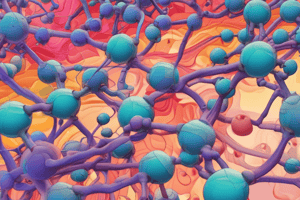Podcast
Questions and Answers
What is polyethylene derived from?
What is polyethylene derived from?
- Ethylene (correct)
- Polymethylmethacrylate
- Propylene
- Polyacrylic acid
Which polymer is produced through the polymerization of propylene?
Which polymer is produced through the polymerization of propylene?
- Polyvinyl chloride
- Polytetrafluoroethylene
- Polypropylene (correct)
- Polymethylmethacrylate
What is the role of free radicals in the polymerization of vinyl compounds?
What is the role of free radicals in the polymerization of vinyl compounds?
- They inhibit the process
- They are catalysts
- They terminate polymer chains
- They initiate the polymerization process (correct)
During which step of the polymerization process are free radicals produced?
During which step of the polymerization process are free radicals produced?
What is the consequence of the decomposition of benzoyl peroxide in polymerization?
What is the consequence of the decomposition of benzoyl peroxide in polymerization?
Which of the following is NOT a polymer listed in the provided information?
Which of the following is NOT a polymer listed in the provided information?
What type of reaction leads to the creation of polymers like PVC and PTFE from their respective monomers?
What type of reaction leads to the creation of polymers like PVC and PTFE from their respective monomers?
What is a significant characteristic of polyblend compared to its constituent polymers?
What is a significant characteristic of polyblend compared to its constituent polymers?
Which statement accurately describes copolymerization?
Which statement accurately describes copolymerization?
What is the role of plasticizers in polymer processing?
What is the role of plasticizers in polymer processing?
Which of the following statements is true regarding ABS copolymer?
Which of the following statements is true regarding ABS copolymer?
What is required for a plasticizer to be effectively used in a polymer?
What is required for a plasticizer to be effectively used in a polymer?
Which type of polymer arrangement does NOT typically include cross-linking?
Which type of polymer arrangement does NOT typically include cross-linking?
Which method for initiating vinyl polymerization directly involves the generation of free radicals through thermal decomposition?
Which method for initiating vinyl polymerization directly involves the generation of free radicals through thermal decomposition?
What role does n,n-dimethyl-p-toluidine play in the polymerization process involving benzoyl peroxide?
What role does n,n-dimethyl-p-toluidine play in the polymerization process involving benzoyl peroxide?
In the propagation phase of polymerization, what is the primary action of the free radical formed during initiation?
In the propagation phase of polymerization, what is the primary action of the free radical formed during initiation?
Which of the following statements about benzoyl peroxide as a polymerization initiator is FALSE?
Which of the following statements about benzoyl peroxide as a polymerization initiator is FALSE?
What is a common application of polymerization techniques involving benzoyl peroxide?
What is a common application of polymerization techniques involving benzoyl peroxide?
Which of the following is an example of a synthetic polymer?
Which of the following is an example of a synthetic polymer?
What is the monomer from which polyethylene is derived?
What is the monomer from which polyethylene is derived?
Which type of polymer is formed from a single type of monomer?
Which type of polymer is formed from a single type of monomer?
In polypropylene, the arrangement of which group can vary?
In polypropylene, the arrangement of which group can vary?
What is the fundamental component of living organisms that is also a polymer?
What is the fundamental component of living organisms that is also a polymer?
What characterizes addition polymerization?
What characterizes addition polymerization?
Which of the following best describes a heteropolymer?
Which of the following best describes a heteropolymer?
What distinguishes isotactic polypropylene from atactic polypropylene?
What distinguishes isotactic polypropylene from atactic polypropylene?
Which example demonstrates an inorganic polymer?
Which example demonstrates an inorganic polymer?
What is the repeating unit in polyethylene?
What is the repeating unit in polyethylene?
What is a defining characteristic of a composite material?
What is a defining characteristic of a composite material?
Which of the following best describes the role of the matrix in a two-component composite?
Which of the following best describes the role of the matrix in a two-component composite?
Which material type in particulate composites is known to possibly reduce cost?
Which material type in particulate composites is known to possibly reduce cost?
What is the primary effect of the orientation or distribution of fibers in a composite material?
What is the primary effect of the orientation or distribution of fibers in a composite material?
Which of the following statements is true regarding whiskers compared to fibers?
Which of the following statements is true regarding whiskers compared to fibers?
In a laminate structure, what is the effect of placing layers of fiber-reinforced resin in different directions?
In a laminate structure, what is the effect of placing layers of fiber-reinforced resin in different directions?
What is the tensile strength range for Aluminium oxide whiskers?
What is the tensile strength range for Aluminium oxide whiskers?
Which fiber type has the lowest tensile strength according to the provided data?
Which fiber type has the lowest tensile strength according to the provided data?
What characterizes elastomers as a material?
What characterizes elastomers as a material?
What effect does cross-linking have on polymer properties?
What effect does cross-linking have on polymer properties?
Which factor does NOT influence the crystallinity of a polymer?
Which factor does NOT influence the crystallinity of a polymer?
What happens to polyethylene when heated above its glass transition temperature?
What happens to polyethylene when heated above its glass transition temperature?
What defines a thermosetting polymer?
What defines a thermosetting polymer?
What does the glass transition temperature primarily indicate for a polymer?
What does the glass transition temperature primarily indicate for a polymer?
How does branched polyethylene differ from linear polyethylene?
How does branched polyethylene differ from linear polyethylene?
What transformation occurs in silicone polymers at temperatures below room temperature?
What transformation occurs in silicone polymers at temperatures below room temperature?
Which characteristic is NOT associated with elastomers?
Which characteristic is NOT associated with elastomers?
What role does the bond strength play in determining a polymer's properties?
What role does the bond strength play in determining a polymer's properties?
Flashcards
Polymer blending
Polymer blending
A process of mixing two or more polymers before molding, creating a new polymer with properties between the originals.
Copolymer
Copolymer
A type of polymer created by combining two or more different monomers during polymerization. The monomers can be arranged randomly or in blocks.
ABS (Acrylonitrile Butadiene Styrene)
ABS (Acrylonitrile Butadiene Styrene)
A copolymer made from acrylonitrile, butadiene, and styrene. The butadiene forms rubbery areas within the rigid polymer matrix.
Miscible polymers
Miscible polymers
Signup and view all the flashcards
Plasticizer
Plasticizer
Signup and view all the flashcards
Plasticizer Compatibility
Plasticizer Compatibility
Signup and view all the flashcards
Activation in Polymerization
Activation in Polymerization
Signup and view all the flashcards
Initiation in Polymerization
Initiation in Polymerization
Signup and view all the flashcards
Propagation in Polymerization
Propagation in Polymerization
Signup and view all the flashcards
Termination in Polymerization
Termination in Polymerization
Signup and view all the flashcards
Free Radical
Free Radical
Signup and view all the flashcards
Monomer
Monomer
Signup and view all the flashcards
Composite
Composite
Signup and view all the flashcards
Matrix
Matrix
Signup and view all the flashcards
Filler
Filler
Signup and view all the flashcards
Particulate Composite
Particulate Composite
Signup and view all the flashcards
Whiskers
Whiskers
Signup and view all the flashcards
Fiber Reinforced Composite
Fiber Reinforced Composite
Signup and view all the flashcards
Fiber Orientation
Fiber Orientation
Signup and view all the flashcards
Laminate Structure
Laminate Structure
Signup and view all the flashcards
What are polymers?
What are polymers?
Signup and view all the flashcards
What is a monomer?
What is a monomer?
Signup and view all the flashcards
What is addition polymerization?
What is addition polymerization?
Signup and view all the flashcards
What is a homopolymer?
What is a homopolymer?
Signup and view all the flashcards
What is a heteropolymer?
What is a heteropolymer?
Signup and view all the flashcards
What is isotactic polypropylene?
What is isotactic polypropylene?
Signup and view all the flashcards
What is syndiotactic polypropylene?
What is syndiotactic polypropylene?
Signup and view all the flashcards
What is atactic polypropylene?
What is atactic polypropylene?
Signup and view all the flashcards
What are inorganic polymers?
What are inorganic polymers?
Signup and view all the flashcards
What is polydimethylsiloxane?
What is polydimethylsiloxane?
Signup and view all the flashcards
Polymerization Initiation
Polymerization Initiation
Signup and view all the flashcards
Benzoyl Peroxide Activation
Benzoyl Peroxide Activation
Signup and view all the flashcards
Tertiary Amine Activation
Tertiary Amine Activation
Signup and view all the flashcards
Polymerization Propagation
Polymerization Propagation
Signup and view all the flashcards
Polymerization Termination
Polymerization Termination
Signup and view all the flashcards
Cross-linking
Cross-linking
Signup and view all the flashcards
Thermoplastic Polymer
Thermoplastic Polymer
Signup and view all the flashcards
Thermosetting Polymer
Thermosetting Polymer
Signup and view all the flashcards
Glass Transition Temperature
Glass Transition Temperature
Signup and view all the flashcards
Elastomers
Elastomers
Signup and view all the flashcards
Crystallinity in Polymers
Crystallinity in Polymers
Signup and view all the flashcards
Polyethylene (Linear)
Polyethylene (Linear)
Signup and view all the flashcards
Branched Polyethylene
Branched Polyethylene
Signup and view all the flashcards
Elastic Modulus
Elastic Modulus
Signup and view all the flashcards
Strain
Strain
Signup and view all the flashcards





